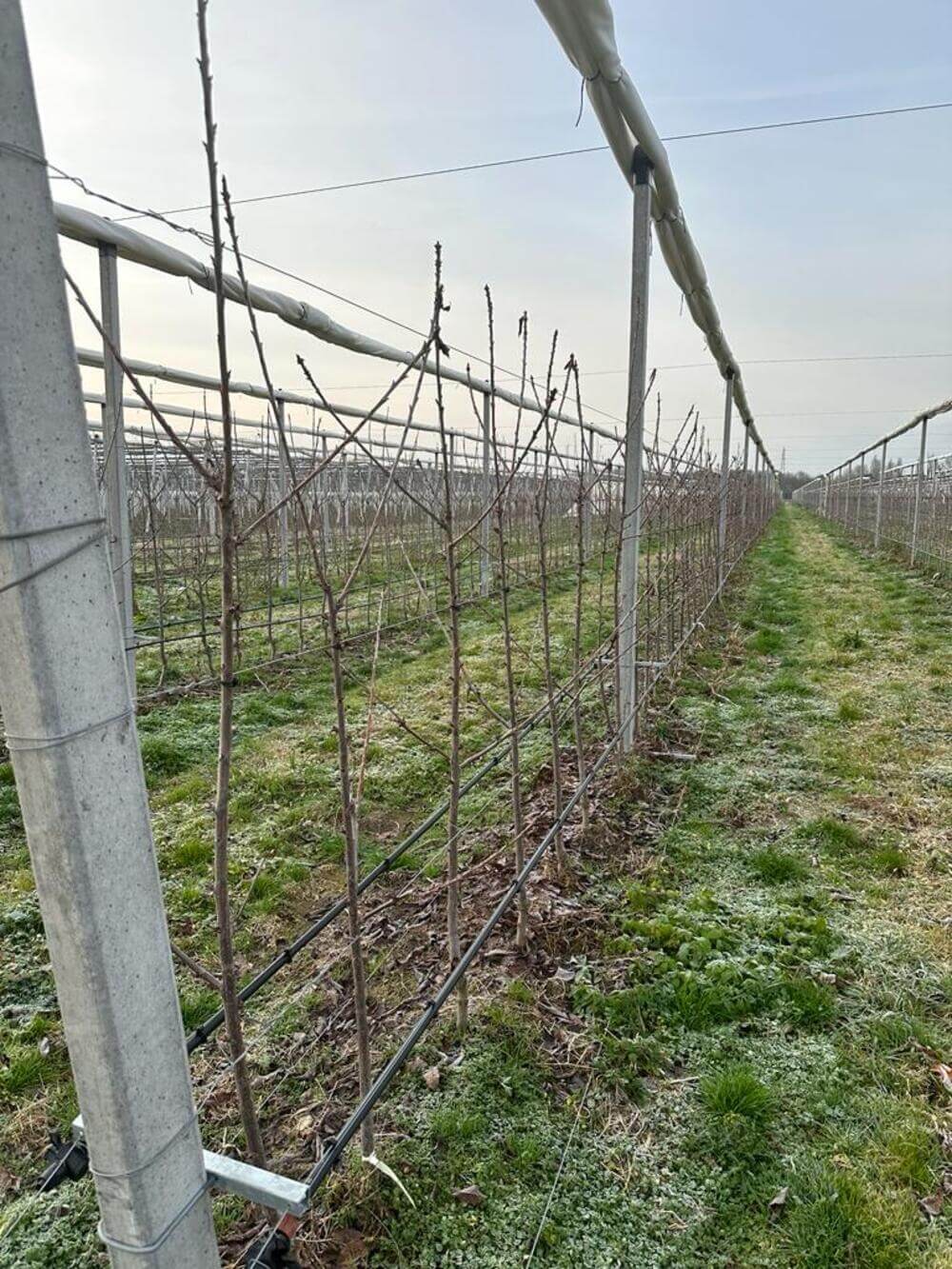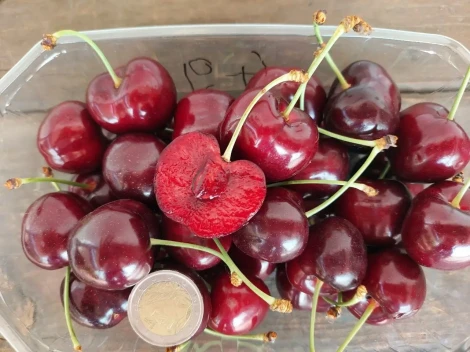The year 2024 starts under the best omen for Salvi Vivai, the Emilia-Romagna-based company has much to celebrate as in 2023 the new experimental cherry orchard was planted and the new micropropagation laboratory officially started. In 2024, the nursery will further increase the production of seedlings, after two years since the start of operations in a small-scale laboratory during which the potential of micropropagation was tested.
Now the official laboratory is ready and the new team is working at full speed to produce the plants already on order. More than 50 years of history for the company during which it has always tried to put innovation at the centre. The nursery company started out by producing apple, pear and peach trees, until it moved on to strawberry and cherry trees in 2006. It has also recently introduced kiwi fruit, both yellow and green.
Less than a year ago, with regard to cherry trees specifically, Salvi Vivai announced the new varieties in their catalogue and also decided to plant a new experimental cherry orchard. Customers can now also choose Pacific Red, Nimba, Areko, Royal Helen and Royal Lafayette, in addition to the varieties that have always been available.
We met (virtually) Silvia Salvi, who leads Salvi Vivai and who last summer was awarded a prize by BPER Banca for the cutting-edge innovation carried out in the nursery business. Of course, the focus of the conversation could only becherry trees.
Since 2006, you have also started to produce cherry trees, what made you choose to take this path?
The cherry project, called 'Ciliegio senza scala' (Cherry trees without ladders), started because we felt that the sector needed innovation, and innovation and research have always been fundamental for us. We wanted to focus on a cherry orchard of low stature, with plants with limited vegetation, and not a traditional cherry orchard. In those years, among other things, rootstocks were coming out that were adapting well, such as the Gisela.
These rootstocks make it possible to have very compact plants, a ceraseto in which all operations are done from the ground, optimising them. They are newly designed plants, which allow a high density, starting from 3,000 up to even 5,000 plants per hectare. When we started with cherry trees we produced between 5 and 10 thousand plants per year, today we produce an average of 400 thousand plants per year. We have been making cherry trees for almost 20 years.
In the beginning our market was only Italian, today we go further afield. We are seeing a great development of cherry growing in Central Northern France, then Germany has always been an important country. And for several years now there has been Eastern Europe investing, Russia but also other countries in that area are planting a lot, especially varieties such as Kordia, Regina, Ferrovia but also the new varieties we have recently introduced are in great demand.
The Sweet series, on the other hand, is particularly successful in Italy and Europe. Among the potentially very interesting areas are South American countries. Unfortunately, to date it is difficult to export plants to that area due to phytosanitary problems; for these countries it is necessary to open bilateral marketing agreements.

What has ensured the success of Sweet? And have you recently introduced new varieties to your catalogue, what guided you in your choice?
The varieties of the Sweet series, developed by the genetic improvement programme of the University of Bologna, are characterised by the fact that they are very similar to each other. It is important to give the consumer the possibility of a fruit that is always similar. They are varieties with excellent characteristics, fruit with excellent size, a sweet taste superior to the norm, crunchy cherries and a dark colour that is much liked and sought after.
These characteristics can be found in all cherries of the Sweet series. The harvest period can last up to one month, 40 days. Even when choosing new varieties to be introduced into the catalogue, we tried to follow the same characteristics, i.e. always large calibre, dark colour. For us it was also essential to extend the harvest period.
We therefore chose both early and late varieties. In this way, the first fruits can arrive around 20 May, in Italy, and the harvest continues until the beginning of July. Extending the harvest period is also a necessity for the farm's labour management.
You have just planted a new experimental cherry orchard, how is it characterised?
The new experimental cherry orchard was planted in 2023 and will replace the old cherry orchard as the plants go into production. It is a two-hectare cherry orchard in the municipality of Portomaggiore, in the province of Ferrara. We have planted the varieties of the Sweet series, continuing the experimental collaboration together with the University of Bologna with Professor Stefano Tartarini and his staff.
Then, in the short term, we will also test the newly licensed varieties. For us, this project is very important because we want to give the producer objective scientific opinions that highlight pros and cons.
We have set up two different types of training, using the dwarfing rootstocks Gisela 5 and 6, one with a candelabra, at 1.5 metres on the row and 3.3 metres between the rows; the other with a high-density columnar axis, at 50 cm on the row and again at 3.3 metres between the rows.
We then chose to cover the plants with two types of hail and rain cover. On the one hand we opted for single-row blocks and on the other for single-row nets. The covers are essential to have protection from water and to prevent cracking.

The new micropropagation laboratory officially started in 2024, what are the advantages of this laboratory?
The laboratory was completed at the end of December 2023, now we are bringing it up to speed. We believe, with this new activity, that we have complete traceability of the supply chain and the possibility of expanding the range of products we can offer the market.
We also believe that we are adding value to our product by providing farms with safe and healthy plants of high quality. It is a great satisfaction for us to have started this micropropagation activity, which we are now expanding. We are realising a dream that has long been in our thoughts.
The decision is also linked to our voluntary adherence to the QVI quality certification. The advantage for the customer is the certainty of healthy, genetically controlled plants. Other important advantages are: the speed of propagation which allows us to tighten production times, thus being faster, and the need for limited space in the early stages of growth with the possibility therefore to produce large quantities of material.
The laboratory, in a way, closes a circle. Of course, we do not only produce cherry, but also kiwi, apple, hazelnut rootstocks and, the latest innovation, the production of blueberry seedlings. In the near future we will also expand with other small fruits. Indeed, another great advantage of the micropropagation laboratory is that it can expand its range of species in a very short time.

Looking to the future of cherry growing, what needs to be worked on?
As far as genetic improvement is concerned, disease-resistant and cracking-resistant varieties are needed. The problem of heavy rains and cold spring returns is very much felt. Planting must also be improved, we need planting systems that are less expensive to run. The costs for producers have risen a lot, from energy to raw materials to labour.
The labour problem is the same all over the world. In the last 10 years it has become increasingly difficult to find skilled labour. We need wax systems that are easy to manage so that it is easier to train labour. Another aspect is the improvement of the quality of the cherries.
If there is no quality, it is difficult to recoup the costs. You have to differentiate yourself and go to market with excellent quality cherries. It is precisely the ladderless cherry system and the range of varieties offered by Salvi Vivai that can help farms achieve this goal.
Barbara Righini
Images: Salvi Vivai
Cherry Times - All rights deserved













